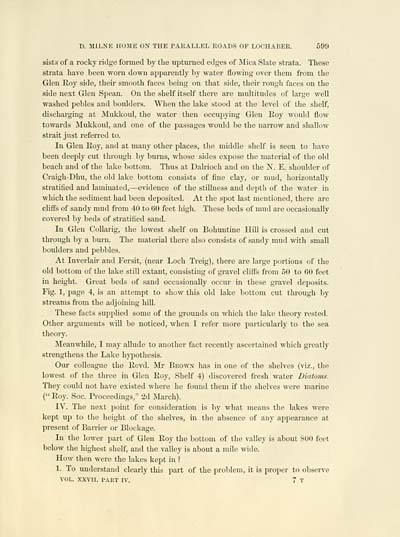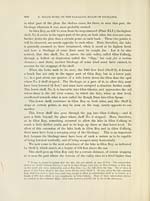Download files
Complete book:
Individual page:
Thumbnail gallery: Grid view | List view

D. MILNE HOME OX THE PARALLEL ROADS OF LOCHABER. 599
sists of a rocky ridge formed by the upturned edges of jNIica Slate strata. These
strata have been worn down apparently by water flowing over them from the
Glen Eoy side, their smooth faces being on that side, their rough faces on the
side next Glen Speau. On the shelf itself there are multitudes of large well
washed jiebles and boulders. When the lake stood at the level of the shelf,
discharging at Mukkoul, the water then occupying Glen Roy would flow
towards iMukkoul, and one of the passages would be the narrow and shallow
strait just referred to.
In Glen Roy, and at many other places, the middle shelf is seen to have
been deeply cut through by burns, whose sides expose the material of the old
beach and of the lake bottom. Thus at Dalrioch and on the X. E. shoulder of
Craigh-Dhu, the old lake bottom consists of fine clay, or mud, horizontally
stratified and laminated, — evidence of the stillness and depth of the Avater in
which the sediment had been deposited. At the spot last mentioned, there are
cliffs of sandy mud from 40 to 60 feet high. These beds of mud are occasionally
covered by beds of stratified sand.
In Glen Collarig, the lowest shelf on Bohuntine Hill is crossed and cut
through by a burn. The material there also consists of sandy mud with small
boulders and pebbles.
At Inverlair and Fersit, (near Loch Treig), there are large portions of the
old bottom of the lake still extant, consisting of gravel cliffs from 50 to 60 feet
in height. Great beds of sand occasionally occur in these gravel deposits.
Fig. 1, page 4, is an attempt to show this old lake bottom cut through by
streams from the adjoining hill.
These facts supplied some of the grounds on which the lake theory rested.
Other arguments will be noticed, when I refer more particularly to the sea
theory.
Meanwhile, I may allude to another fact recently ascertained which greatly
strengthens the Lake hj^iothesis.
Our colleague the Revd. Mr Brown has in one of the shelves (viz., the
lowest of the three in Glen Roy, Shelf 4) discovered fresh water Diatoms.
They could not have existed where he found them if the shelves were marine
(" Roy. Soc. Proceedings," 2d March).
IV. The next point for consideration is by what means the lakes were
kept up to the height of the shelves, in the absence of any appearance at
present of Barrier or Blockage.
In the lower part of Glen Roy the bottom of the valley is about 800 feet
below the highest shelf, and the valley is about a mile wide.
How then were the lakes kept in ?
1. To understand clearly this part of the problem, it is proper to observe
VOL. XXVII. PART IV. 7 T
sists of a rocky ridge formed by the upturned edges of jNIica Slate strata. These
strata have been worn down apparently by water flowing over them from the
Glen Eoy side, their smooth faces being on that side, their rough faces on the
side next Glen Speau. On the shelf itself there are multitudes of large well
washed jiebles and boulders. When the lake stood at the level of the shelf,
discharging at Mukkoul, the water then occupying Glen Roy would flow
towards iMukkoul, and one of the passages would be the narrow and shallow
strait just referred to.
In Glen Roy, and at many other places, the middle shelf is seen to have
been deeply cut through by burns, whose sides expose the material of the old
beach and of the lake bottom. Thus at Dalrioch and on the X. E. shoulder of
Craigh-Dhu, the old lake bottom consists of fine clay, or mud, horizontally
stratified and laminated, — evidence of the stillness and depth of the Avater in
which the sediment had been deposited. At the spot last mentioned, there are
cliffs of sandy mud from 40 to 60 feet high. These beds of mud are occasionally
covered by beds of stratified sand.
In Glen Collarig, the lowest shelf on Bohuntine Hill is crossed and cut
through by a burn. The material there also consists of sandy mud with small
boulders and pebbles.
At Inverlair and Fersit, (near Loch Treig), there are large portions of the
old bottom of the lake still extant, consisting of gravel cliffs from 50 to 60 feet
in height. Great beds of sand occasionally occur in these gravel deposits.
Fig. 1, page 4, is an attempt to show this old lake bottom cut through by
streams from the adjoining hill.
These facts supplied some of the grounds on which the lake theory rested.
Other arguments will be noticed, when I refer more particularly to the sea
theory.
Meanwhile, I may allude to another fact recently ascertained which greatly
strengthens the Lake hj^iothesis.
Our colleague the Revd. Mr Brown has in one of the shelves (viz., the
lowest of the three in Glen Roy, Shelf 4) discovered fresh water Diatoms.
They could not have existed where he found them if the shelves were marine
(" Roy. Soc. Proceedings," 2d March).
IV. The next point for consideration is by what means the lakes were
kept up to the height of the shelves, in the absence of any appearance at
present of Barrier or Blockage.
In the lower part of Glen Roy the bottom of the valley is about 800 feet
below the highest shelf, and the valley is about a mile wide.
How then were the lakes kept in ?
1. To understand clearly this part of the problem, it is proper to observe
VOL. XXVII. PART IV. 7 T
Set display mode to: Large image | Transcription
Images and transcriptions on this page, including medium image downloads, may be used under the Creative Commons Attribution 4.0 International Licence unless otherwise stated. ![]()
| Early Gaelic Book Collections > J. F. Campbell Collection > On the parallel roads of Lochaber > (23) |
|---|
| Permanent URL | https://digital.nls.uk/80970286 |
|---|
| Description | Volumes from a collection of 610 books rich in Highland folklore, Ossianic literature and other Celtic subjects. Many of the books annotated by John Francis Campbell of Islay, who assembled the collection. |
|---|
| Description | Selected items from five 'Special and Named Printed Collections'. Includes books in Gaelic and other Celtic languages, works about the Gaels, their languages, literature, culture and history. |
|---|

